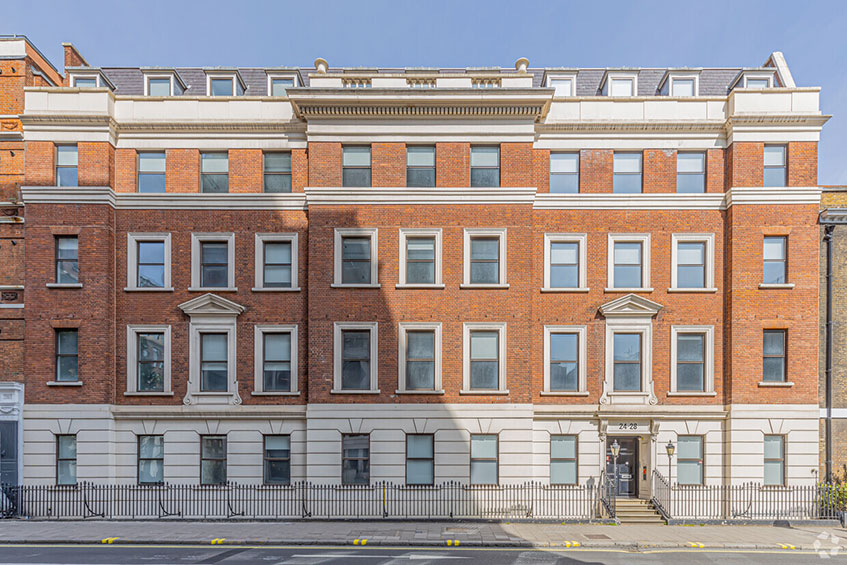Rent review clause in lease of premises to the Secretary of State–Award by arbitrator in the form of a special case for decision of the High Court under section 21(1)(b) of the Arbitration Act 1950–Rent from review date to be the ‘rack rental market value’ as defined in the lease–Question of law as to whether account had to be taken of the possibilities of continuation or renewal of tenancy under Part II of the Landlord and Tenant Act 1954–Held that the hypothetical landlord and tenant competing in the market would bear in mind the possibilities of continuation or renewal–Hence the rent should be the higher of the two rents mentioned in the award–Tenant’s contrary submissions rejected
This was a
special case stated by the arbitrator, who framed his award in the form of a
special case under section 21 of the Arbitration Act 1950 for the decision of
the court. The arbitration concerned the true construction of the rent review
clause in an underlease between Pivot Properties Ltd as lessors and the
Secretary of State for the Environment as lessee. The properties subject to the
lease in question were Lunar House and Apollo House, Wellesley Road, Croydon.
J S Colyer QC,
G W Seward and K M J Lewison (instructed by Goodman, Derrick & Co) appeared
on behalf of the claimants, Pivot Properties Ltd; M A B Burke-Gaffney QC
(instructed by the Treasury Solicitor) represented the respondent Secretary of
State.
Giving
judgment, PHILLIPS J said: This is an award by an arbitrator stated in the form
of a special case under section 21(1)(b) of the Arbitration Act 1950 in an
arbitration between Pivot Properties Ltd as claimants and the Secretary of
State for the Environment as respondent. The dispute between the parties
concerns the construction of a rent review clause contained in an underlease
made on August 4 1971 between Pivot Properties Ltd as lessors and the Secretary
of State for the Environment as lessee, whereby land and buildings known as
Lunar House and Apollo House in the County Borough of Croydon were let to the
lessee for a term of 42 years from June 24 1971 at a rent of £785,000 for the
period from August 5 1971 to August 5 1972 and thereafter at a yearly rent of
£1,570,000, subject to the provisions as to rent review.
The buildings
are described in the underlease as being ‘lately erected.’ I have been shown photographs of them and, as
the rent suggests, they are very large.
Clause 7 of
the underlease provides as follows:
IT IS HEREBY
AGREED AND DECLARED as follows:
(1) The Lessors shall have the right to call for
a review of the yearly rent for the time being payable hereunder at each of the
following dates (hereinafter referred to as ‘the review date’) namely
Twenty-fourth
day of June 1978
Twenty-fourth
day of June 1985
Twenty-fifth
day of December 1990
Twenty-fourth
day of June 1996
Twenty-fifth
day of December 2001
Twenty-fourth
day of June 2005
Twenty-fifth
day of December 2010
(2) The said right shall be exercised by the
Lessors giving to the Lessee not less than six months’ notice in writing prior
to a review date.
(3) If and so often as the Lessors shall give to
the Lessee such notice as aforesaid then from and after a review date this
Lease shall be read and construed and shall take effect in all respects as if
the yearly rent for the time being payable hereunder had from such review date
been the rack rental market value (as hereinafter defined) of the demised
premises but without prejudice to any of the other terms and conditions
contained in this Lease and so that in no event shall the rent payable by the
Lessee to the Lessors after a review date be less than the rent payable by the
Lessee to the Lessors immediately before a review date.
(4) For the purpose of this clause the rack
rental market value of the demised premises at any review date shall (subject
as hereinafter provided) be the amount which shall be agreed between the
Lessors and the Lessee (or in default of agreement be determined by arbitration
as hereinafter provided) to be the best rent at which the demised premises
might reasonably be expected to be let in the open market as a whole for a term
not exceeding five years and one half of another year and subject to similar
covenants and conditions (other than the amount of the rent and the provisions
of this present clause for reviewing the rent) to those contained in this Lease
there being disregarded:
(a) Any effect on rent of the fact that the
Lessee has or his predecessors in title or by any undertenant or undertenants
of the Lessee or his predecessors in title have been in occupation of the
demised premises or any part thereof.
(b) Any goodwill then attaching to the demised
premises or any part thereof by reason of the carrying on on the demised
premises or on some part thereof whether by the Lessee or by his predecessors
in title or by any undertenant or undertenants of the Lessee or his
predecessors in title of any business or businesses therein.
(c) Any effect on rent of any improvement
carried out by the Lessee or any person deriving title under the Lessee with
the consent of the Lessors otherwise than in pursuance of an obligation to the
Lessors.
(5) If by three calendar months prior to any
review date the Lessors and the Lessee have failed to agree upon the rack
rental market value of the demised premises as at any review date then and in
such case the question shall forthwith be referred upon the request of either
party to the decision of some competent person to be nominated by the President
for the time being of the Royal Institution of Chartered Surveyors and these
presents shall be deemed to be a submission to Arbitration within the meaning
of the Arbitration Act 1950 or any statutory modification or re-enactment
thereof for the time being in force and the decision of such person (including
any decision as to the costs of such arbitration) shall be binding on both the
Lessors and the Lessee.
(6) Until such time as the amount of any increase
in the rent reserved by this Lease shall have been settled the Lessee shall
continue to pay such rent as is payable by this Lease immediately prior to any
review date on the dates and in manner hereinbefore provided and when the
amount of any increase has been settled the Lessors will serve upon the Lessee
a notice in writing specifying the amount and demanding payment thereof and the
first payment of the rent to which such notice relates shall immediately become
due and payable in respect of the period from the review date to the following
quarter day.
(7) SUBJECT as hereinbefore provided to the
contrary and to any award as to costs made by an Arbitrator the Lessors and the
Lessee shall each bear their own costs of ascertaining the rack rental market
value of the demised premises at any time for the purpose of this present
Clause.
The lessors
having called for a review of the rent as from June 24 1978 and the parties
having failed to agree, the arbitrator was duly appointed to determine the rent
in accordance with clause 7 and, at the request of the parties, stated his
award in the form of a special case for the decision of the court. The award
states the question of law as follows:
Whether upon
the true construction of the underlease made on August 4 1971 the rack rental
market value of the premises (which is to be assessed on the assumption that
they are to be let as a whole for a term of 5 1/2 years) is also to be assessed
upon the assumption that no account is to be taken of any possibility of the
tenancy being continued or renewed under the provisions of Part II of the
Landlord and Tenant Act 1954.
The award
continues as follows:
(1) In the event of the Court deciding the
question of law in the affirmative I award as follows: (i) That the rent for
the period 24 June 1978 to 23 June 1985 shall be at the annual rate of Two
Million One Hundred Thousand Pounds (£2,100,000). . . . (2) In the event of the
Court deciding the question of law in the negative I award as follows: (i) That
the rent for the period 24 June 1978 to 23 June 1985 shall be at the annual
rate of Two Million Nine Hundred and Twenty-Five Thousand Pounds (£2,925,000).
. . .
It will be
observed that those paragraphs are expressed in the negative. The first of the
two alternatives takes no account of the matter stated; the latter takes
account of the matter stated.
The parties
were agreed that the length of the term to be considered by the arbitrator for
the purposes of clause 7(4) was five and a half years.
Thus the
question for my decision is whether in assessing under clause 7(4) the best
rent at which the premises might reasonably be expected to be let in the open
market as a whole for a term of five and a half years and subject to similar
covenants and conditions (other than the amount of the rent and the provisions
of clause 7(4) for reviewing the rent) to those contained in the underlease,
account is to be taken of any possibility of the tenancy being continued or
renewed under the provisions of Part II of the Landlord and Tenant Act 1954. Mr
Burke-Gaffney for the lessee submitted that no account should be taken of this
possibility; Mr Colyer for the lessors submitted that it should, and the
arbitrator was of opinion that it should.
As will have
been seen from the extracts from the award set out above, a lot hangs on the
answer to the question posed for my decision: £825,000 a year until 1985; and
over the whole term £28,000,000, according to Mr Burke-Gaffney, or £14,000,000,
according to Mr Colyer. The question is one of general importance in other
cases also.
The provisions
of Part II of the Landlord and Tenant Act 1954 relating to business tenancies
are well-known to property owners and especially their professional advisers.
Thus we are not here concerned with some obscure or little-known part of the
law. There is no doubt that the existence of the Act of 1954 has an effect on
the level of rents of business premises. Thus, assuming business premises to be
offered for a term of five years, a bidder in the market, bearing in mind the
possibilities of a continuation or renewal of the tenancy, will tend to offer
more than he would do if the Act did not exist and there was no such
possibility. Mr Burke-Gaffney agreed that this is so. His argument was
different, namely that to take account of the possibilities of continuation or
renewal of the term postulated by clause 7(4) is inconsistent with and
repugnant to the terms of the underlease and its tenor. Apart from this dispute
there is agreement between the parties as to how the rack rental market value
ought to be determined in accordance with clause 7(4). Thus the lessor and the
lessee are hypothetical, it being assumed that the hypothetical lessor and the
hypothetical lessee are willing negotiators in the open market for a term of
five and a half years of the actual land and buildings on the covenants and
conditions of the underlease, save where otherwise stated in clause 7(4).
In Priestman
Collieries Ltd v Northern District Valuation Board [1950] 2 KB 398,
Morris J at p 407, delivering the judgment of the court, said this:
In the
opinion of the court, the phrase ‘open market’ in section 13(4) of the Act
(that is the Coal Industry Nationalisation Act 1946) does not contemplate a
purely hypothetical market which is to be regarded as exempt from any
restrictions imposed by law. The section does not postulate conditions wholly
divorced from reality. The directed inquiry in effect is: ‘what would the sale
of the unit have realised on January 1 1947?’
In pursuing that inquiry it must be assumed that on that date the seller
was willing to sell and that the buyer was willing to buy; any notion of a
compulsory sale must be ignored. The seller must be deemed to have done as well
as a willing seller would reasonably have been expected to do on January 1
1947. But that does not mean that he should be regarded as a person not bound
by the law. It must be assumed that he would deal on the market on January 1
1947, subject to the law of the land. Any restriction or limitation imposed on
him by law or imposed on any willing buyer must be recognised and taken into
account. The sale to be regarded for the purposes of section 13(4) must be a
notional one, but a notional sale in the market in which and subject to the
conditions under which willing buyers and sellers could legitimately have
operated on January 1 1947. It is enjoined by section 13(5) that regard should
be had ‘to all relevant circumstances.’
What is contemplated, therefore, is a sale that might have taken place
in the actual market on the prescribed date–rebus sic stantibus.
Although the
terms of that Act, of course, were particular, it seems to me that similar
considerations apply in the present case. See also East End Dwellings Co Ltd
v Finsbury Borough Council [1952] AC 109.
So the parties
and the term are hypothetical, but the figure at which the parties would settle
has to be determined according to the facts as they are in the real world, rebus
sic stantibus, save in so far as reality is contradicted by the hypothesis.
In the real world, for reasons given earlier in this judgment, I consider that
the hypothetical tenant in making his bid and the hypothetical landlord in
deciding whether to accept it would bear in mind the possibilities of a
continuation or a renewal of the term in accordance with the provisions of the
Act of 1954. Uncertainties, for example due to a contention that the provisions
did not apply, or to a possibly successful opposition by the landlord under section
30, or a possible repeal of the Act, would be allowed for in the process of
negotiation, in the case of agreement, or of valuation in the case of reference
to arbitration. Such uncertainties would not lead to the possibilities being
disregarded. There is here a real possibility to be assessed and the situation
seems to me to be quite different from that which obtained in Plinth
Property Investments Ltd v Mott, Hay & Anderson (1979) 249
ESTATES GAZETTE 1167, a decision of the Court of Appeal, upholding a decision
by Slynn J given on May 30 1977, relied upon by Mr Burke-Gaffney. There the
arbitrator had to determine the rent of premises let upon terms containing a
restriction as to user, the effect of which would be to depress the rent. The
question was whether the arbitrator must take into account the possibility that
the landlord would relax the restriction. The arbitrator, Slynn J, and the
Court of Appeal all said: ‘No.’ Two
reasons were relied upon for this conclusion. First, that the possibility of
relaxation was so intangible that it could not be assessed; secondly, that to
assume such a possibility would be to depart from the terms of the lease under
which the rent was being assessed. The first reason is that given by Lord
Denning MR and Shaw LJ in the Court of Appeal and to some extent it was relied
upon by Slynn J and Brandon LJ. The second reason appears to have been that
principally relied upon by Slynn J and Brandon LJ.
Perhaps Mr
Burke-Gaffney may derive some support from the principle behind the second
reason, but, as I have said,
possibility of the hypothetical tenant enjoying a continuation or renewal of
the term at the date of its expiry seems to me to be a real one, and just as
much a part of the real world as the state of the market, the rate of inflation
or the merits of building. Experienced surveyors when making valuations are
well accustomed to taking into account possibilities of this character. The
arbitrator in the present case seems to have had no difficulty. The parties
have clearly been able to make their submissions upon value allowing for this
possibility. Nor do I think there is any reason to suppose that the
hypothetical tenant would–whether for technical reasons, see Compton Group
Ltd v Estates Gazette Ltd (1978) 36 P&CR 148 at p 157; (1977)
244 EG 799 at p 805, [1977] 2 EGLR 73–or otherwise not enjoy the possibility
of benefiting under the Act of 1954. In any event, others competing with him in
the market certainly would and their competition would help to set the market
rate.
It struck me
at the outset of the case, and I still think, that clause 7(4) is oddly worded,
and I cannot help wondering whether there has not been some slip in the
drafting. In giving directions to the parties or the arbitrator as to the basis
upon which the rack rental market value of the premises is to be agreed or to
be determined, one would have expected an exact formula to be prescribed, yet
the phrase, ‘a term not exceeding five years and one half of another year’
leaves it to the parties to agree or determine one of the principal features by
which the rent is to be fixed. Nor is it apparent what criteria should be taken
into account in so deciding the length of the term. It is, it seems to me, an
odd way of proceeding to leave it to the arbitrator, subject to the upper
limit, to determine for himself the very measure which he is to apply. This
peculiarity perhaps makes it difficult to know what weight to attach to the words
‘not exceeding’ on which Mr Burke-Gaffney relied. His principal submission, put
in a variety of ways, was that taking into account the possibility of a
continuation or a renewal of the hypothetical term could be inconsistent with
and repugnant to the terms of the underlease and in particular clause 7(4). The
directions in that clause, he said, are perfectly clear and base the assessment
on a term not exceeding five and a half years. The express words could not be
departed from, or any implication relied upon, and that to take into account
the possibilities under the Act of 1954 would be to substitute a term in excess
of that prescribed by the underlease. He relied on Affreteurs Reunis Societe
Anonyme v Leopold Walford (London) Ltd [1919] AC 801 and London
Export Corporation Ltd v Jubilee Coffee Roasting Co Ltd [1958] 1 WLR
661. It was also inconsistent with those cases, he said, for the arbitrator to
have to go into the realms of conjecture and speculation which taking into
account the possibilities under the Act of 1954 would involve.
The principle
of those cases is not in doubt, but I do not think that there is any express
inconsistency or repugnancy here. In the first place, I cannot see that the
words ‘not exceeding’ can directly assist Mr Burke-Gaffney’s submission to the
contrary, though they may perhaps contribute to the atmosphere, and thus to the
tenor of the underlease upon which he relies. Those words are merely a
direction to the parties or the arbitrator to be used in determining the length
of the hypothetical term or, as Mr Colyer put it, they are mere words of
limitation and are not words describing the attributes or consequences of that
term. In this sense, said Mr Colyer, they are commonly used in statutes: see,
for example, section 33 of the Landlord and Tenant Act 1954, section 54 of the
Law of Property Act 1925, section 41 of the Settled Land Act 1925 and section
123 of the Local Government Act 1972. I think that this is correct. So Mr
Burke-Gaffney’s submission of inconsistency in terms is no stronger than it
would be if clause 7(4) had specified the length of the term precisely, say
five and a half years. Secondly, and in that event, I do not think that there
would be any such express inconsistency or repugnancy. To take account of the possibilities
under the Act of 1954 is not to assess the rent for a term longer than five and
a half years, as Mr Burke-Gaffney contended, but to assess the rent for a term
of five and a half years, one of the potentialities of which is that it may be
continued or renewed. This potentiality is as much an ingredient contributing
to its value as other characteristics such as the terms and conditions of the
lease.
So I reject
this part of Mr Burke-Gaffney’s submissions. But he put the case more broadly
and submitted that to take into account the possibilities under the Act of 1954
is inconsistent with the tenor or the substance of the underlease. I agree that
in a case of this kind it will not do to be too technical and that I should be
wary of the skilful logic of Mr Colyer’s argument which, as logically-riveted
chains of argument sometimes do, might lead to a foolish result; in other
words, keep an eye on the commonsense of it. The difficulty in this is that if
I am right in saying that in the ordinary way a bidder for a term of business
premises would take into account the possibilities under the Act of 1954 (and
this was not disputed) there is little on which to found the view that to do so
in this case is contrary to the tenor, substance or spirit of the underlease.
All that can be said on this is that the underlease directs the assessment of
the rent for a term of five and a half years and that it is therefore forbidden
to look beyond the end of that period. By itself this seems to me to carry the
argument no further. None the less, I can see that this could be a peg on which
to hang Mr Burke-Gaffney’s contention, if it could be shown that the claimants’
contention leads to an absurd result. Accordingly, I thought it right to
inquire during the course of the hearing whether the result arrived at by the
arbitrator, that is taking into account the possibilities under the Act of
1954–I do not mean the mere quantum of the assessment–was in principle
unreasonable or absurd. While no concession was made, Mr Burke-Gaffney
disclaimed any contention to the effect that the claimants’ contention leads to
an absurdity.
Indeed, it
seems to me, it may lead to a more sensible result than the respondent’s. It is
common ground that the reasons for the large difference between the alternative
awards (£825,000) is connected with the huge size of the buildings. The cost of
occupation of such buildings would be so large that there would be great
reluctance to take them except for a period which would make it worthwhile to
incur such costs. A renewal at intervals of between five and seven years
throughout a term of 42 years, at which the rent was assessed on each occasion
on the basis of a letting for a term not exceeding five and a half years, would
not, except at the end of the term, seem to reflect the reality of the
situation. In a sense, this is an aside and I merely pray it in aid negatively
as not supporting the view that the claimants’ contention here leads to
absurdity.
Finally, it
should be noted that clause 7(4) lists a number of matters to be disregarded in
determining the rent and that the provisions of the Landlord and Tenant Act
1954 are not among them; and that the subclauses to clause 7(4) seem to be
borrowed or adapted from section 34 of that Act.
So, at the end
of the day, the position is this: I accept Mr Colyer’s arguments to the effect
that the hypothetical tenant and the hypothetical landlord competing in the
market would take into account the possibilities of the tenant obtaining a
continuation or renewal of the term. I do not find any express inconsistency
here with the terms of the underlease, nor can I say that to take into account
such possibilities is inconsistent with the tenor or substance of the
underlease. It is not contended that the claimants’ case leads to an absurdity.
Accordingly, I find in favour of the claimants and answer the question of law
posed for my decision: No.
Judgment was
given for the claimants in the arbitration, Pivot Properties Ltd, with costs.
Leave was given to the respondent, the Secretary of State for the Environment,
to appeal. The answer given to the specific question raised in the special case
was ‘No,’ the effect being that the possibilities
Tenant Act 1954 were to be taken into account in determining the rent under the
review clause.










